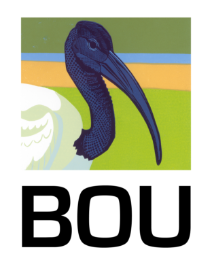
LINKED PAPER
King Penguins adjust foraging effort rather than diet when faced with poor foraging conditions. Brisson-Curadeau, E., Bost, C.-A., Cherel, Y., Elliott, K. 2024. IBIS. DOI: 10.1111/ibi.13287. VIEW
What do you do if your favourite food isn’t available anymore? Do you try harder to find it, or do you eat something else instead? For generalist species, being able to switch to alternative prey during times of shortage can be an advantage, and even dietary-specialist species can often be flexible in times of hardship. However, some specialist species have been shown to increase foraging effort rather than shift their diet. With marine environments facing ongoing environmental pressures, knowing how particular seabird species might adapt to low prey availability can help to predict future population trends.
In a recent Ibis study, Émile Brisson-Curadeau and colleagues used tracking and isotopic data to investigate the links between foraging success, foraging effort and diet in a colony of King Penguins (Aptenodytes patagonicus), a specialist deep-diving seabird.
King Penguins
King Penguins feed mainly on small mesopelagic myctophids. The study population of the Ratmanoff colony in the Kerguelen archipelago primarily feed on Krefftichthys anderssoni, with the remainder of their diet (up to 25%) made up from opportunistically feeding on other prey such as other fish species and squids (Bost et al. 2002). During the study period of 2015 to 2022 (excluding 2019), data was obtained during the chick-rearing period when parents make trips at sea of 4-10 days. Observations of lower chick mass in 2015 and 2016 indicated these years may have been less favourable for the penguin population (Brisson-Curadeau et al. 2023).
The isotopic niche described by stable isotopes of nitrogen (δ15N) and carbon (δ13C) from blood samples can be used a proxy of a consumer’s trophic niche, being indicative of the consumer’s trophic position (reflecting their diet) and foraging habitat respectively (Hobson et al. 1994, Quillfeldt et al. 2005, Cherel & Hobson 2007). The researchers created several linear mixed effects models to test how blood δ15N and δ13C values were influenced by foraging effort variables (mean diving depth, total vertical distance travelled, trip duration, mean distance from the colony), foraging success metrics (mass gained per day and Prey Capture Attempts (PCAs) per day), mean thermocline depth, mean latitude, and mean longitude. They also tested the influence of the foraging effort variables on the foraging success metrics.

Figure 1. Annual variation of foraging effort variables (middle and left graphs) as well as foraging success variables (right graphs) among sampled King Penguins breeding at Kerguelen Island. Numbers in the boxes indicate the number of King Penguins sampled. Stars indicate years that were significantly different from at least two other years when conducting Tukey’s tests. The black lines represent the median.
Isotopes and diet specialism
The results indicated that even when encountering highly variable foraging conditions, the King Penguin does not greatly vary its diet in terms of trophic position (δ15N), but instead relies on increasing foraging effort to compensate for low prey capture rates.
There was a strong longitudinal gradient of δ13C in the environment near Kerguelen, although in the Southern Ocean δ13C gradients are usually latitudinal (Cherel & Hobson 2007). At a smaller scale, 13C is depleted in offshore habitats relative to coastal habitats, and as the Kerguelen Plateau extends south of the island to Heard Island, penguins foraging south will remain in the same shelf habitat while those foraging east encounter deeper bathymetry, likely explaining the gradient in δ13C as habitat changes with longitude.

Figure 2. Mean diving position of foraging King Penguins during breeding. Each point represents a King Penguin’s trip. Colours represent blood δ13C (‰) of the King Penguin at the end of the foraging trip, after returning to the colony. Notice the strong East–West gradient, with blood δ13C values decreasing when King Penguins forage farther off the island’s shelf.
The researchers did not detect spatial gradients influencing δ15N at a local scale near Kerguelen, meaning it was a fair assumption that δ15N could be used to assess the trophic position of King Penguins. As all alternative prey of King Penguins in the study area have a higher δ15N value than their main prey, it was expected that low foraging success individuals would have a higher δ15N value due to becoming more opportunistic. However, blood δ15N values did not increase or decrease significantly with substantially different foraging effort, foraging success, and marine conditions encountered by the Kerguelen King Penguins, and in fact the δ15N range was very narrow across both individuals and years suggesting little variation in diet. However, as some alternative prey have relatively close δ15N values to Krefftichthys anderssoni it is possible that more subtle prey switches could go undetected using this method.
The results confirmed that King Penguins are very restrictive in their foraging strategy and targeted prey. The foraging success indices were negatively correlated with trip duration, suggesting that, unsuccessful individuals stayed at sea for longer to compensate for low prey availability rather than changing their foraging strategy and diet.
Based on the results, it is suspected that the population parameters of this species is tightly linked to the availability of its main prey. As foraging effort cannot increase indefinitely, such strict specialists might encounter issues such as breeding failures and/or at-sea mortality if their prey composition started shifting in future. Ongoing population monitoring and long-term prey surveys are valuable to detect changes and predict future bottom-up effects affecting seabirds, and are likely to be increasingly important for conservation of these species in the face of climate change.
References
Bost, C.A., Zorn, T., Le Maho, Y. & Duhamel, G. (2002). Feeding of diving predators and diel vertical migration of prey: King penguins diet versus trawl sampling at Kerguelen Islands. Marine Ecology Progress Series 227: 51–61. VIEW
Brisson-Curadeau, É., Handrich, Y., Elliott, K.H. & Bost, C.A. (2021). Accelerometry predicts prey-capture rates in the deep-diving king penguin Aptenodytes patagonicus. Marine Biology 168: 1–10. VIEW
Brisson-Curadeau, É.,Elliott, K. & Bost, C.A. (2023). Contrasting bottom-up effects of warming ocean on two king penguin populations. Global Change Biology 29: 998–1008. VIEW
Cherel, Y. & Hobson, K.A. (2007). Geographical variation in carbon stable isotope signatures of marine predators: A tool to investigate their foraging areas in the Southern Ocean. Marine Ecology Progress Series 329: 281–287. VIEW
Hobson, K.A., Piatt, J.F. & Pitocchelli, J. (1994). Using stable isotopes to determine seabird trophic relationships. Journal of Animal Ecology 63: 786–798. VIEW
Quillfeldt, P., McGill, R.A. & Furness, R.W. (2005). Diet and foraging areas of Southern Ocean seabirds and their prey inferred from stable isotopes: review and case study of Wilson’s storm-petrel. Marine Ecology Progress Series 295: 295–304. VIEW
Image credits
Top right: King penguins (Aptenodytes patagonicus), South Georgia | Sastognuti | CC BY-SA 4.0 Wikimedia Commons
Blog posts express the views of the individual author(s) and not those of the BOU.
If you want to write about your research in #theBOUblog, then please see here





